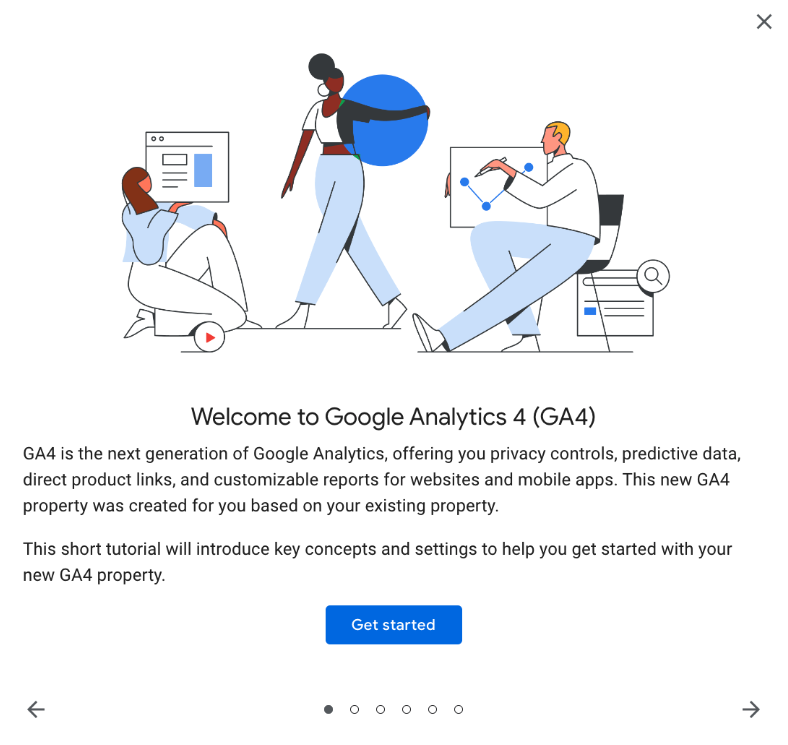Welcome to the ultimate guide on GA4! As experts in this field, we at Idaho Style are committed to keeping you informed about the latest updates on Google Analytics 4, as well as its benefits, drawbacks, and alternative solutions. GA4 is a powerful tool that offers a range of exciting features and benefits, from improved data modeling to integration with Google Ads and other platforms. However, it’s not without its challenges and limitations. That’s why we are giving you this comprehensive guide to help you navigate the complex world of GA4 and explore other solutions that may be better suited to your business needs. So whether you’re an experienced marketer or just getting started with Google Analytics, we invite you to join us on this journey and discover the good, the bad, and the alternatives to GA4.
When it comes to digital marketing, success hinges on data. By adopting a data-driven approach, you can effectively monitor performance, pinpoint areas for improvement, and gain valuable insights into your customer journey. This is where digital analytics, particularly Universal Analytics, comes into play. As the free version of Google Analytics, it currently holds a whopping 86% market share. However, things are about to change.
Universal Analytics will no longer be available starting from October 1, 2023. This means that Google Analytics 4 (GA4) will be the sole tool for data processing and website activity tracking. It’s important to note that while Universal Analytics 360 (for enterprises) will cease data processing standard UA properties (non-enterprise) will be phased out by July 1, 2023.
What is GA4?
Although there are numerous GA4 guides available, we will provide you with a concise summary. Prior to October 2020, Universal Analytics served as the default property type for websites, being the preferred choice for digital analytics. However, everything changed on October 14, 2020, with the release of GA4. Now, when creating a property, a Google Analytics 4 property becomes the default option, representing the next generation of digital analytics.
Why make the change if Universal Analytics was so popular? Well, there are a few reasons. First, there have been changes to online privacy policies that need to be addressed. Second, consumer behavior has also shifted, necessitating a new approach. Additionally, there is a need to view the customer journey as a whole, which led to the development of a new and improved analytics tool.
With the introduction of cross-platform tracking, you can now gather web and app data simultaneously, gaining insights into user behavior across multiple platforms. And that’s not all. The new analytics tool also incorporates AI-driven predictive analytics, machine learning, data visualization, and a heightened focus on customer privacy. This is the future of digital analytics.
GA4 vs Universal Analytics
While GA4 allows tracking of activity across web and app data streams, providing a comprehensive view of user interactions, how does the new Google Analytics differ from Universal Analytics in other aspects?
- A new dashboard
Say goodbye to the old and hello to the new – in this scenario, a sleeker user interface or dashboard. While it may take a moment to adjust to the updated reporting interface, you’ll gain increased control. The navigation bar now features buttons for the home page, reports, advertising, explore, configure, and library. Additionally, you’ll have access to predictive insights powered by Google’s AI.
- New measurements
While Universal Analytics focused on page views, GA4 shifts its focus to events. This transition brings about a more comprehensive measurement, providing a deeper insight into user interactions with marketing campaigns, mobile apps, and websites.
- New integration with Google ads
If you’ve been longing to measure your app and web integrations simultaneously, you’ll be delighted to discover that GA4 offers this capability. You can monitor your app and web conversions across Google Ads and various other platforms, spanning from social media to email. It serves as a comprehensive analysis hub, providing you with a quick overview of your performance across multiple channels and revolutionizing your data collection process.
- New metrics
GA4 utilizes new metrics such as engaged sessions, engagement rate, and engagement time to monitor the customer journey. Although there may be a learning curve, these new data streams provide a comprehensive understanding of the behavior and interactions of your active users.
- New predictive insights
By utilizing AI metrics such as purchase probability, churn probability, and revenue prediction, you can make data-driven decisions that are tailored to the predicted behavior of your users. This will allow you to enhance your performance, reach new audiences, and personalize your brand experience to align with the desires and needs of your users.
- New reporting
Gain insights into your customer lifecycle by leveraging new reports on acquisition, engagement, monetization, and retention. These reports provide enhanced visibility and in-depth analysis of user interactions, empowering you to track and optimize your customer journey.
- New control
GA4 provides enhanced user privacy by offering more detailed controls over user data. Instead of relying on cookies, GA4 adopts a data modeling approach to address gaps in inaccessible data. This ensures that privacy is given equal importance as data collection.
- New cross-platform tracking
GA4 now has the ability to track both app and web data simultaneously, spanning from email to website to social media and mobile apps. With this GA4 property, you can monitor user behavior comprehensively, capturing all interactions and touchpoints across various platforms. It provides a holistic view of the user experience in one place.
How GA4 Can Help You
Considering a transition to GA4? You’re not the only one. By March 2023, approximately 8.4 million websites have already embraced Google Analytics 4. And it’s not limited to large corporations; even smaller WordPress sites and Shopify stores are reaping the rewards. Curious about how? Take a peek!
- Combined web and app tracking
Having a comprehensive view of the user journey is crucial for better understanding. This is exactly what GA4 accomplishes by collecting data from various platforms and presenting it in a unified data stream, providing a convenient overview of the customer lifecycle. With GA4’s ability to capture user interactions as events, including conversion events, you can simultaneously analyze web and app data. This enhanced measurement helps optimize online and website performance.
- Simpler data analysis
In the digital realm, success hinges on captivating your users, and this is where GA4’s machine learning and AI capabilities shine. Anticipating your customer’s behaviors allows you to provide them with more of what they desire, creating a mutually beneficial outcome. Thanks to GA4’s user-friendly data analysis, you can enhance your website’s performance, make data-driven decisions with greater insights, and ultimately add more value to your overall business.
- New audience creation
By having improved tools and measurements, you can create new and more influential audiences, leading to a significant boost in your bottom line. Utilize GA4’s predictive metrics to optimize your audiences and ad spending, and witness your return on investment (ROI) thrive.
- More sophisticated privacy features
Many businesses utilize cookies to monitor user interactions, leading to concerns about the type of data being tracked and gathered. With the latest GA4 update, you’ll have greater control over the data collection process. This not only ensures compliance with privacy regulations but also enhances your business’s adaptability and flexibility in a future where cookies are less prevalent and data modeling takes precedence.
How GA4 is Improving
Since May 2023, Google has added the following updates to GA4:
- Funnel reports: Generate personalized funnel reports that monitor user progress throughout task completion and analyze user attrition at each stage.
- Audience builder: Enhanced flexibility and increased control in audience creation.
- Business objectives collection: You can generate customized reports to fit your business needs, enabling you to access pertinent data and information aligned with your objectives.
- Search console recommendation: To access Google Organic Search Queries and Google Organic Search Traffic reports, you can link your Search Console with your Google Analytics account.
- Improvements to reusing analytics.js website tags: By having your website tagged with analytics.js, you can simplify and streamline the process of migrating to GA4 by reusing your existing tags.
- Integration with AdSense: By connecting your AdSense account to a GA4 property, you can access your AdSense data directly in your GA4 reports. This provides you with fresh insights to enhance your ad revenue.
Making The Move To GA4
Should your business make the move to GA4? This is a question that only you can answer. One thing is certain though, with the upcoming sunset of Universal Analytics, you’ll need to make a decision sooner rather than later. Consider the benefits, challenges, and alternatives of GA4 when making your choice.
Some Alternatives
Considering these challenges, is it essential to transition to GA4? If you prefer not to utilize cookie-free tracking or monitor user events, are there alternative solutions that can be explored instead? Fortunately, yes, there are various options available, such as:
- Adobe Analytics
In the realm of big business, Adobe Analytics takes the lead with its premium analytics package. It provides comparable data and measurements to GA4, but with a more sophisticated reporting structure. However, the drawback is its steep price. To get the details on the premium cost, you’ll need to reach out to Adobe directly.
- Matomo Analytics
Gain control over your data by using Matomo Analytics, a competitor of Google Analytics that has been around since 2007. It is trusted by over 1.4 million websites in 190 countries, making it one of the most popular analytics platforms available. Matomo not only complies with privacy laws but also offers additional features not found in GA4, such as SEO keyword reporting, heatmaps, and A/B testing. With a seamless migration from Universal Analytics, a free version (with limitations), and affordable paid options starting at just $23 per month, Matomo could be the perfect alternative to GA4 that you’ve been searching for.
- Fathom Analytics
If you prioritize user privacy, you’ll need an analytics platform that does too. That’s where Fathom Analytics comes in. Fully compliant with data regulations like GDPR, CCPA, ePrivacy, and PECR, Fathom provides web analytics without the use of cookies and without storing users’ data. With its privacy-first approach, unified dashboard, and simplified operations, Fathom is perfect for small businesses. It offers three different plans to choose from, starting at just $14 per month.











